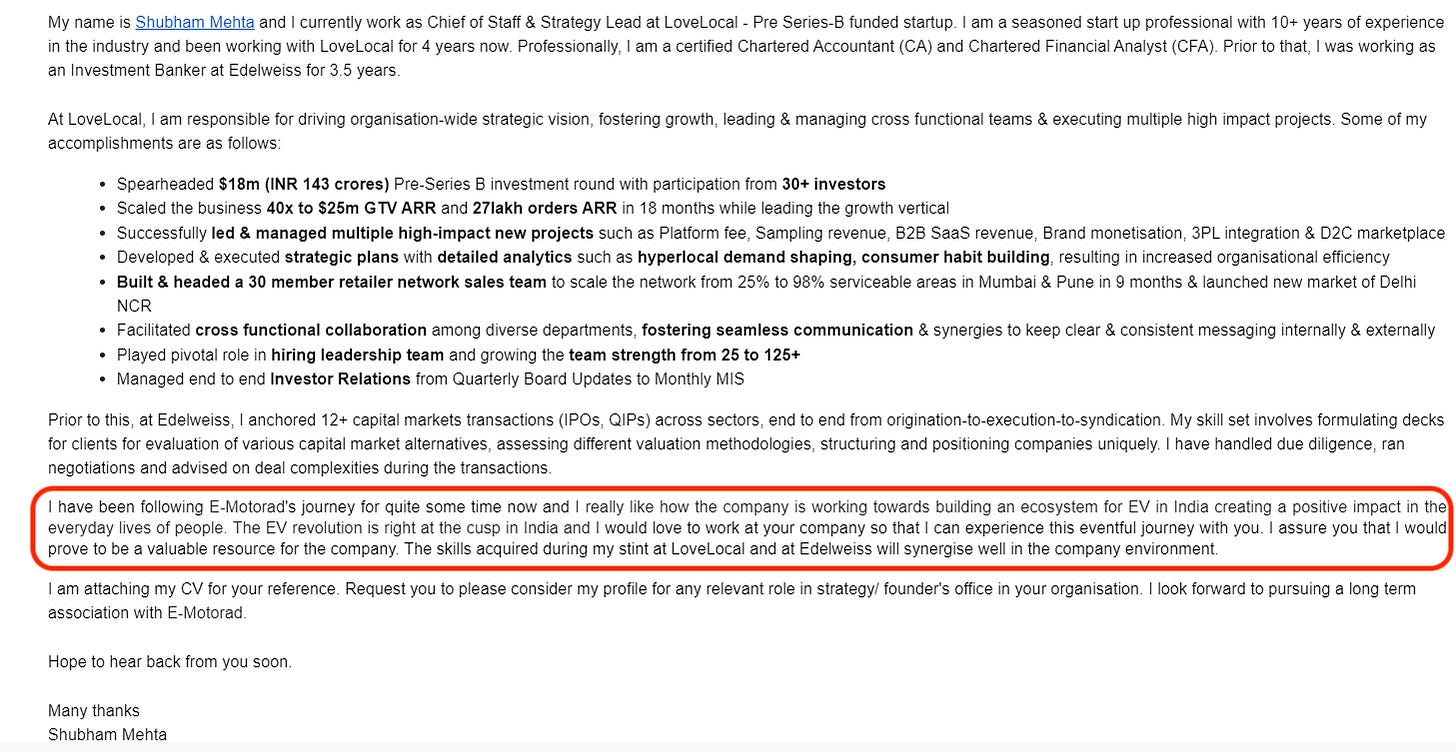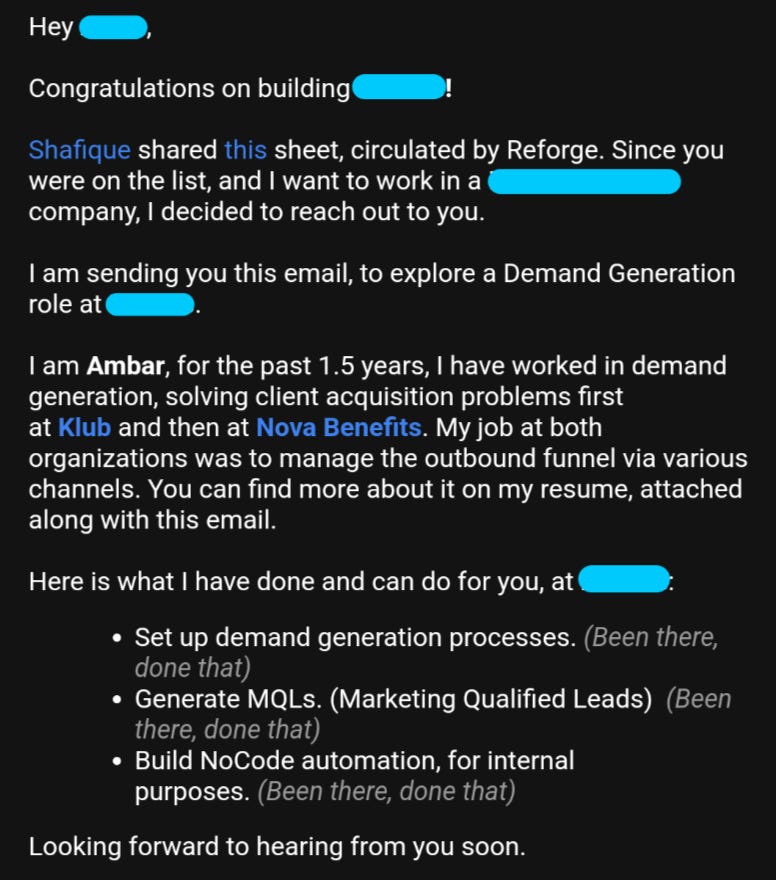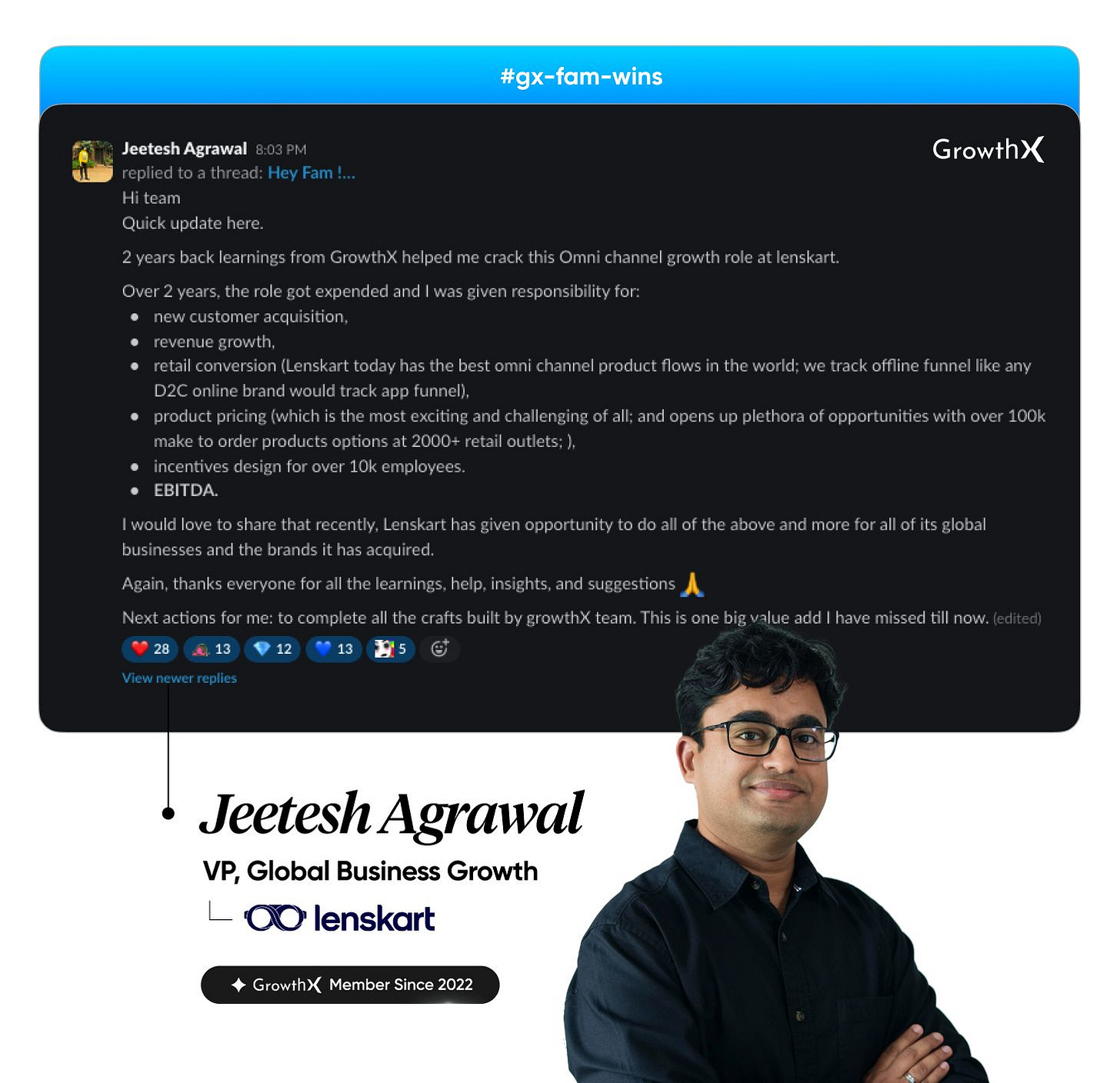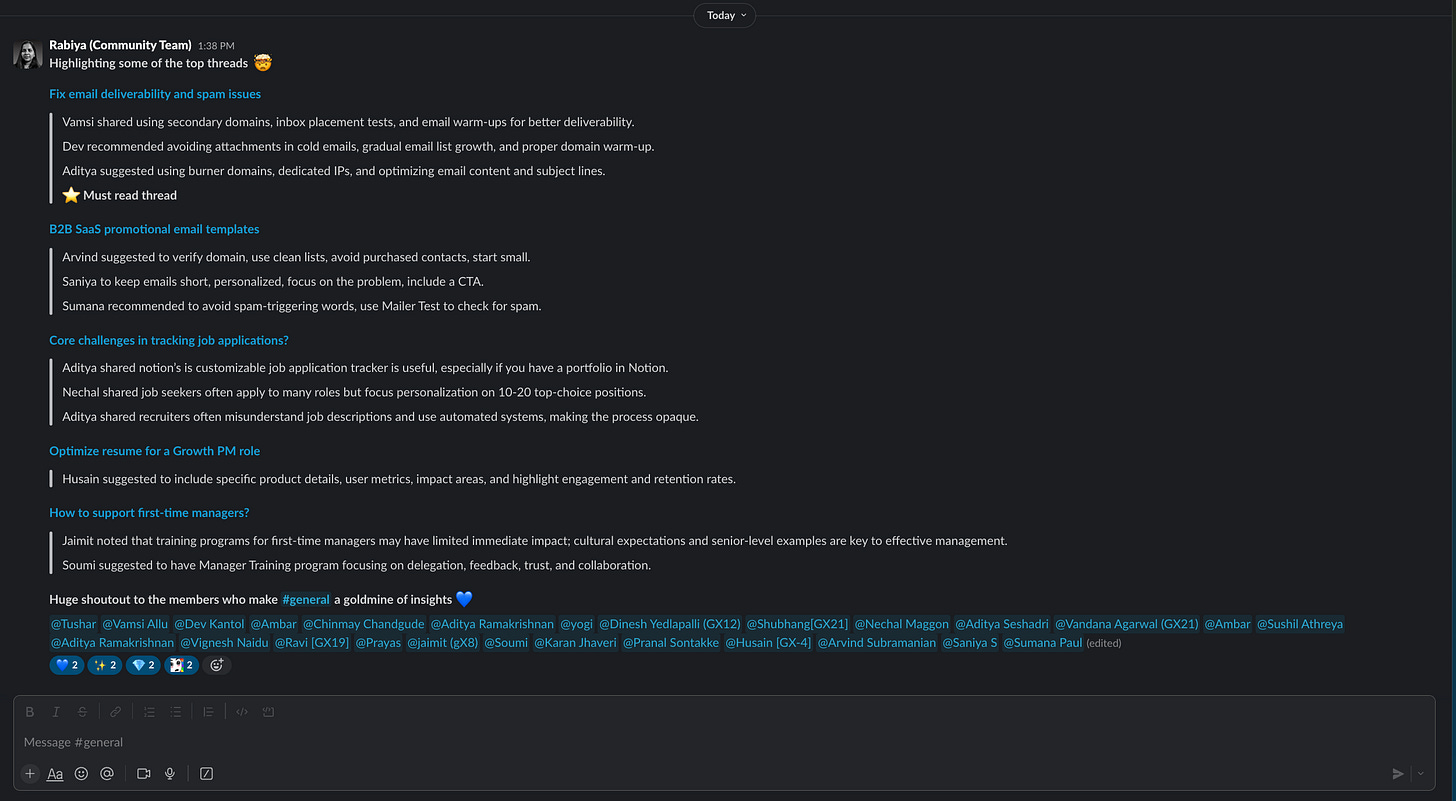Founders want you to do a cold reach-out, but
They are busy and won't even read? wrong. You will be prioritized and fast-tracked if you do it the right way.
Are you actively looking to crack a role?
It’s an overly crowded job market, and hence more important than ever to get basic hygiene in place. Nailing the first impressions is critical. Over the past 2 years, we have worked with hundreds of members to help them identify, crack and thrive in their dream roles. And now, you can access all the collective learnings and resources in one place.
Introducing personal branding to help you increase your chances of getting shortlisted for a role.
We have put together a step-wise guide for you, right from cracking the accurate positioning to pitching yourself in a way that establishes relevancy for the role. Across your LinkedIn, resume, and portfolio with tonnes of specific examples relevant to your goals, find everything.
Getting to today’s edition.
We’ve all been there — staring at the blinking cursor, drafting that one cold email or message hoping it’ll unlock a conversation. But what separates a generic reach-out from one that grabs attention? Let’s learn today.
We’re diving into the anatomy of a great cold outreach message. Here’s everything we will cover -
Doing your homework on the receiver, company, industry, users & more.
Drafting the pitch to show clear value, focusing on personalisation
Closing it strong & making it easy for the reader to reply back
Powerpacked with insights from Leaders / Founders who are on the receiving end.
Ready? Let’s break it down.
Step 1/ Do your homework
Here’s the thing - without understanding the person and the company well, you can’t build your case. When you reach out to someone via email/ LinkedIn, you have the reader’s attention only for a few seconds, if you do not make it personalised - you are losing this game.
But how do you do it? You will find all the information by digging up on -
Company website, LinkedIn, Twitter, Instagram, YouTube, etc
[Look for everything that helps you understand - Who they are, what are they building, what’s the vision, everything about the product & more.]
Founders/ leaders background, posts, articles/podcasts/features if any
[Is there any common thread that you can use as a reference?]
Latest news about the company related to funding, product launch, announcements, etc. [Ensure you are up-to-date with the information available out there]
Speak to a couple of users if you can, and get to know their experience using the product. [Honestly, nothing like speaking to users, that gives you insane leverage and deeper insights.]
Don’t have access to the users? Even app store reviews can help you with what people are saying about the product.
Personal experience: Two years back, I spoke to members of the fam including Meghna, Priyanka to learn about their experience at GrowthX, before my first chat with AP. In fact, I met Nikita offline in Bangalore, she was a Demo Day panellist at GrowthX and knew AP personally. You will see how it came together, towards the end of this newsletter.
Moving ahead, list down everything that you find out in one place. Use it when you start writing the message draft. Remember, you don’t need to force all the information in, use only what’s relevant to the person and the role. Right from the first reachout, to the interviews and then negotiation - your research will be your anchor. This helps you constantly establish the ‘why’ of building in this space & working on the product that matters to you.
Let’s also understand what the hiring managers have to share about cold reach-outs.
When we connected with him, Saket mentioned the candidate was interviewed and hired. Now, what stood out? ‘Effort the person took to find good insights and the context to show why he is interested.’
Even Vignesh Naidu, Head of Digital Acquisitions at IDFC First Bank [from GX21] said - "I get a lot of cold reachouts from candidates. There is nothing that I remember that was particularly good, most of them are the usual cover letter format asking for referral which I unfortunately don't respond to. I respond when they have done some research on both the company and me, highlighting why I should consider them. “
Do you see why and how your research sets the stage for a more meaningful conversation? See you have to understand that these folks are already getting an insane number of requests asking them for a job/ referral. If you are unable to distinguish yourself, you are getting ignored. This is why personalisation is the key.

The bottom line here is to use your research for a personalised approach when reaching out.
Step 2/ Nail the hook of the message
The first 3 lines either make or break for you, it decides if someone will continue to read your message.
The subject line is the first (and sometimes the only) thing people read. It needs to compel them to open your email. A strong subject line should be concise, relevant, and pique curiosity.
Avoid clickbait or overused phrases like "Just following up", "Quick question”, “looking for a referral”, or “Are you hiring for this role?”. Instead, you can write - Excited about [Product] and have an idea that could boost retention by 20%. Here, you’re immediately showing that you have something valuable to share.
Coming to the main content, the first line should quickly establish common ground. A compliment that shows genuine interest or acknowledgement of the recipient’s work can build an instant connection. Mention a recent post, a product launch, or a shared interest — something that shows you’ve done your homework. This approach makes the reader feel seen and valued.
Step 3/ Mention what you bring to the table
For a lot of folks, logos/brand of the companies they have worked at & the tenure of work itself is a leverage. Here, keeping it crisp helps because there’s so much credibility your profile already depicts.
But if that’s not the case for you, remember - numbers to the rescue. Here’s an example of what Shubham Mehta [Founder’s Office at EMotorad] wrote to the Founder and cracked the role.
This demonstrates your skills in the exact area that’s relevant to the recipient’s needs — it’s tangible, data-driven, and helpful.
Small personal touches can make a big difference. This not only shows attention to detail but also proves you're genuinely interested in them, not just sending a mass message. For example -
Another example is from Ambar who is currently working as a Growth strategist [GX10], he sent this cold email and got the role too.
This way, you make the outreach feel like a conversation, not a pitch.
An effective way to build trust
Sometimes, what seals the deal is proof of your expertise. You can stand out by attaching or linking your portfolio, a project you’ve worked on, or data that supports your claims. When you demonstrate you’re capable of delivering results, the reader is more likely to respond. You can simply hyperlink your proof of work document in your email saying - "Here’s a case study of how I increased lead generation by 25% for a SaaS company in three months. I believe similar strategies could be adapted for [Company]."
Step 4/ Make it easy to reply
Don’t overwhelm the recipient with multiple requests. Try to focus on a single, clear ask. Make it actionable, like setting up a quick call next week. Avoid vague requests like “Let me know your thoughts.” You can instead write - "Would you be open to a quick 10-minute chat next week? I’d love to share how my campaign optimization ideas have helped startups increase their customer acquisition by 30% in under six months."
This shows respect for their time and makes it easy for them to respond. The closing should reaffirm your ask and create a sense of urgency without being pushy. End on a strong note.
Looking back on it, I would do a bunch of things differently but that’s a learning that I have tried to sum up for you in this whole newsletter.
Putting it all together
Once your research is in place, start drafting the message - proofread, check for grammatical errors, schedule it for the right time. Also, in general the learning is - early stage founders [Series A and below] will respond faster, compared to large orgs. So identify the right person to reachout to based on the scale of the company.
Length and contents of your message should be personalised based on the receiver, role & company.
Deploy, learn and iterate. What has worked for someone else might not work for you, so don’t copy paste it as is. Use what’s relevant, build your own version and keep optimizing it for best results.
Writing a good cold outreach message isn’t about luck. It’s about understanding the person you’re writing to, offering clear value, and making it easy for them to say yes.
Celebration of fam-wins continues -
Jeetesh Agrawal (GrowthX member since 2022) is now the VP of Global Business Growth at Lenskart.com ✨
Featured roles this week ✨
Senior growth marketer at Bright Money [An AI-driven Fintech for US consumers to manage debt]
Marketing manager at Mariana AI [Research labs building AI models exclusively for Healthcare]
Product manager at Kazam [Agnostic EV charging software platform building India's largest EV charging station network]
Curated resources for you 🚀
How to analyse a head of marketing job description?
[Podcast] Landing your dream job, Lenny with Phyl Terry
[Events] Meet the GrowthX Fam offline
[Discussion] What’s the core challenge with applying to jobs? find out
[Insights] Top conversations in the community this week
That’s all from my end for this week!
If you are planning to send out a cold reach-out email/ message, send the draft and I will help you refine it.
We will work together to make sure you hear back on it!











